
Handicrafts are more than just beautiful objects; they are a window into the culture and history of a community. These items, made by hand, often using traditional methods, tell stories that machines simply can't replicate. From intricate beadwork to delicate pottery, each piece carries the essence of its creator. Handicrafts also play a significant role in sustainable living, as they often use natural, locally-sourced materials. They provide livelihoods for artisans, preserving skills passed down through generations. Whether you're a collector or just curious, learning about handicrafts can deepen your appreciation for these unique creations. Ready to dive into 26 fascinating facts about handicrafts? Let's get started!
The History of Handicrafts
Handicrafts have been around for centuries, showcasing human creativity and skill. Here are some fascinating facts about their history.
- Ancient Origins: Handicrafts date back to ancient civilizations like Egypt and Mesopotamia, where artisans created pottery, jewelry, and textiles.
- Medieval Guilds: During the Middle Ages, craftsmen formed guilds to protect their trade secrets and ensure quality.
- Renaissance Revival: The Renaissance period saw a resurgence in handicrafts, with artists like Michelangelo and Leonardo da Vinci creating masterpieces.
- Industrial Revolution Impact: The Industrial Revolution led to mass production, but it also sparked a renewed interest in handmade goods as a reaction against machine-made items.
Types of Handicrafts
Handicrafts come in various forms, each with unique techniques and materials. Let's explore some popular types.
- Pottery: Pottery involves shaping clay into functional or decorative items, then firing them in a kiln.
- Weaving: Weaving uses threads or fibers to create textiles, often on a loom.
- Embroidery: Embroidery adds decorative designs to fabric using needle and thread.
- Woodworking: Woodworking crafts items from wood, ranging from furniture to intricate carvings.
- Metalworking: Metalworking shapes metal into tools, jewelry, and sculptures.
- Glassblowing: Glassblowing involves shaping molten glass into various forms by blowing air through a tube.
Cultural Significance
Handicrafts hold deep cultural significance, reflecting the traditions and values of different societies.
- Indian Handicrafts: India is famous for its diverse handicrafts, including intricate textiles, pottery, and jewelry.
- African Masks: African tribes create masks for rituals and ceremonies, each with unique designs and meanings.
- Native American Crafts: Native American tribes produce beadwork, pottery, and woven baskets, often with symbolic patterns.
- Japanese Origami: Origami, the art of paper folding, is a traditional Japanese craft with cultural and spiritual significance.
- Mexican Talavera: Talavera pottery from Mexico is known for its vibrant colors and intricate patterns.
Economic Impact
Handicrafts play a significant role in the economy, providing livelihoods and promoting tourism.
- Employment: Millions of people worldwide rely on handicrafts for their income, especially in developing countries.
- Tourism: Handicrafts attract tourists, boosting local economies and preserving cultural heritage.
- Fair Trade: Fair trade organizations support artisans by ensuring they receive fair wages and work in safe conditions.
- Export Revenue: Countries like India and China export handicrafts, generating substantial revenue.
Environmental Benefits
Handicrafts often have a smaller environmental footprint compared to mass-produced goods.
- Sustainable Materials: Many handicrafts use natural, renewable materials like wood, clay, and fibers.
- Low Energy Consumption: Handicraft production typically requires less energy than industrial manufacturing.
- Waste Reduction: Artisans often repurpose materials, reducing waste and promoting recycling.
Modern Trends
Handicrafts continue to evolve, blending traditional techniques with modern trends.
- DIY Culture: The rise of DIY culture has popularized handicrafts, with people creating their own handmade items.
- Online Marketplaces: Platforms like Etsy provide a global market for artisans to sell their crafts.
- Fusion Crafts: Modern artisans often combine techniques from different cultures, creating unique fusion crafts.
- Sustainable Fashion: Handcrafted fashion items, like jewelry and clothing, are gaining popularity for their uniqueness and eco-friendliness.
Crafting a Legacy
Handicrafts hold a special place in our hearts and history. They connect us to our roots, showcasing the creativity and skill passed down through generations. Each piece tells a story, reflecting the culture and traditions of its origin. Supporting artisans not only preserves these traditions but also fosters sustainable practices and fair trade.
Next time you see a handmade item, remember the dedication and passion behind it. Whether it's a woven basket, a carved wooden figure, or an intricate piece of jewelry, handicrafts are more than just objects—they're a testament to human ingenuity and perseverance.
So, let's celebrate and cherish these unique creations. By doing so, we honor the artisans and ensure that their craft continues to thrive for future generations. Handicrafts are not just products; they're a legacy worth preserving.
Was this page helpful?
Our commitment to delivering trustworthy and engaging content is at the heart of what we do. Each fact on our site is contributed by real users like you, bringing a wealth of diverse insights and information. To ensure the highest standards of accuracy and reliability, our dedicated editors meticulously review each submission. This process guarantees that the facts we share are not only fascinating but also credible. Trust in our commitment to quality and authenticity as you explore and learn with us.


